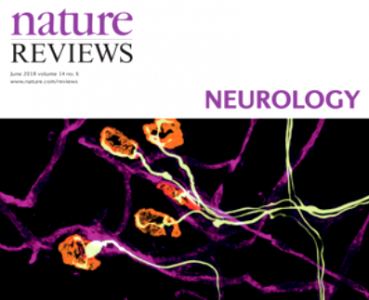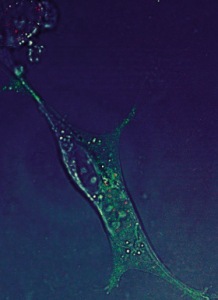作者:土豆
根据Acta Neuropathologica(IF 12.213)发表的一项新研究,外泌体可以介导阿尔茨海默病(AD)毒性淀粉样蛋白-β(Aβ)的细胞间的病理传播。此外,研究人员能够阻止这种外泌体介导的传播,这表明该机制是阿尔茨海默病中的新型治疗靶点。
先前的研究已经证明Aβ可以以朊病毒样的方式从一个细胞传播到另一个细胞。然而,Aβ在细胞间转移的机制尚不清楚。在他们的新研究中,Martin Hallbeck及其同事研究了外泌体在转移毒性淀粉样蛋白-β寡聚体(oAβ)中是否有作用。
“外泌体由胞内体而形成,我们从早期的研究中得知,Aβ的细胞内毒性聚集体通常在胞内体中结束,”Hallbeck解释说。 “从这个角度来看,我们推测这些聚集体可能以外泌体的形式出现,从而传播到下一个细胞。”
为了验证他们的假设,研究人员首先分析了四名AD患者的死后脑样品中oAβ的细胞定位。他们确定oAβ与外泌体共定位。此外, AD患者的外泌体相关oAβ浓度高于没有患有神经疾病的患者。
为了确定外泌体是否可以在细胞之间转移oAβ,研究人员从AD患者的死后脑组织中分离出外泌体,并将它们在培养的细胞系中进行实验。“不仅这些外泌体会被细胞吸收,而且这些细胞还将外泌体携带的oAβ传播到另一组共培养细胞中,”Hallbeck解释说。“这个传播过程也会对神经元细胞产生毒性。”
体外培养的人类神经细胞摄取来自阿尔茨海默病脑组织外泌体的示意图。 外泌体(绿色)和淀粉样蛋白-β寡聚体(红色)能够共定位(黄色)。 图片来自M. Hallbeck实验室。
毒性oAβ可以通过外泌体传播的这个过程,是否可以用一些方法抑制掉。 Hallbeck及其同事进行了实验,验证是否可以阻止外泌体和其有毒货物离开细胞,或阻止它们进入。
“令人兴奋的是,通过siRNA抑制外泌体的形成和释放以及使用外泌体吸收的抑制剂可以阻止外泌体、寡聚体和毒性oAβ的传播,”Hallbeck说。
研究结果可能对研究AD的领域带来新的影响。研究人员说,来自AD患者的外泌体和来自对照个体的外泌体之间的差异意味着可以使用含有oAβ的外泌体作为疾病的生物标志物,尽管需要进一步的工作来证实这种可能性。但也许最令人兴奋的是这种新的治疗方法具有可能性。
“这项工作和其他一些研究蛋白质聚集形式的潜在受体的研究表明,疾病传播背后的这些机制可以作为新药或者新治疗方式的靶标。”Hallbeck总结说。
Acta Neuropathol论文摘要:
The gradual deterioration of cognitive functions in Alzheimer's disease is paralleled by a hierarchical progression of amyloid-beta and tau brain pathology. Recent findings indicate that toxic oligomers of amyloid-beta may cause propagation of pathology in a prion-like manner, although the underlying mechanisms are incompletely understood. Here we show that small extracellular vesicles, exosomes, from Alzheimer patients' brains contain increased levels of amyloid-beta oligomers and can act as vehicles for the neuron-to-neuron transfer of such toxic species in recipient neurons in culture. Moreover, blocking the formation, secretion or uptake of exosomes was found to reduce both the spread of oligomers and the related toxicity. Taken together, our results imply that exosomes are centrally involved in Alzheimer's disease and that they could serve as targets for development of new diagnostic and therapeutic principles.
参考文献:
- Sinha, M. S. et al. Alzheimer’s disease pathology propagation by exosomes containing toxic amyloid-beta oligomers. Acta Neuropathol. https://doi.org/10.1007/s00401-018-1868-1 (2018)
- Fyfe I. Exosomes can spread toxic AD pathology. Nat Rev Neurol. 2018 Jun 22. doi: 10.1038/s41582-018-0039-2.






